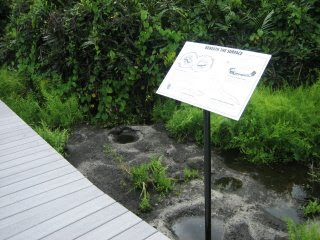The site where Kelonia is situated was once a coral farm , where coral was used to make cement between the 1940s and 1960s. In 1977, the site was converted into a turtle farm, with hatchlings collected from the turtle nesting islands of Europa and Tromelin being reared to adulthood, for their meat and shell, the latter of which is still being used in Artisanal Jewellery in Reunion today.
 Artisans in Reunion are licensed to make jewellery from Green turtle shell left over from the turtle farm – when the stocks runs out the industry will automatically close down, photo Elke Talma.
Artisans in Reunion are licensed to make jewellery from Green turtle shell left over from the turtle farm – when the stocks runs out the industry will automatically close down, photo Elke Talma.In August 2006, the Kelonia Turtle Observatory came into being taking on many of the captive bred turtles already living at the turtle farm. With some minor modifications to the facility the site now hosts over 100,000 visitors a year eager to learn more about turtles and their land based cousins, the tortoise.
The public portion of Kelonia has a main viewing tank where the public can see 4 of the 5 species of turtles known to occur in the Indian Ocean. The tank has a capacity of 500 m3 and currently hosts 5 turtles, which means that each turtle has a personal space of about 100 m3 each.
Visitors to Kelonia not only get to see turtles from the surface but can also get a great underwater view, with Carotte the loggerhead usually hogging the large perspex window. .
The touch tank allows visitors to bond with Blanche, and while only 20 m3 in size, it is wide enough to give Blanche room to move, especially when she no longer wants to be petted by curious onlookers.
The rest of the Turtle Observatory is off limits to the public although they can get a birds-eye view of the daily activities carried out by the staff. It has 4 sections: the male holding tank, the female holding tank, the care centre and the reproduction tank. The male holding tank currently has 3 Green turtles and has a capacity of 175 m3 giving each turtle a personal space of just under 60 m3. While the female holding tank currently has 5 Green turtles and has a capacity of 250 m3, giving each turtle a personal space of just under 50 m3.
The reproduction tank currently has 7 Green turtles, all females as the last male got attacked by the ladies and is currently being looked after by Bernadin and his team in the Care Centre. This tank has a capacity of 300 m3 giving each turtle a personal space of just under 43 m3. The tank also features a sand beach with beach-crest vegetation to allow the turtles to nest normally.
 Turtles resting in the shallow end of the reproduction tank with the sand beach in the foreground, photo Elke Talma.
Turtles resting in the shallow end of the reproduction tank with the sand beach in the foreground, photo Elke Talma.In the Care Centre, sick or injured turtles are kept in individual tanks which come in 2 sizes. The small tanks have a capacity of 2 m3 while the larger tanks can hold 10 m3 of sea water. Generally, captive breed animals are kept in the smaller tanks while wild animals that have been injured and brought to the centre are first kept for a short period in a 2 m3 quarantine tank to get rid of internal and external parasites, before being moved to the larger tanks. The space is limited in these care tanks as the animals need plenty of rest to speed up recovery.
There are two additional pens for land tortoise. These animals were donated by people of Reunion who no longer wanted them as pets. There are 10 Madagascar Radiated tortoises and 2 Aldabra Giant tortoises.


















































